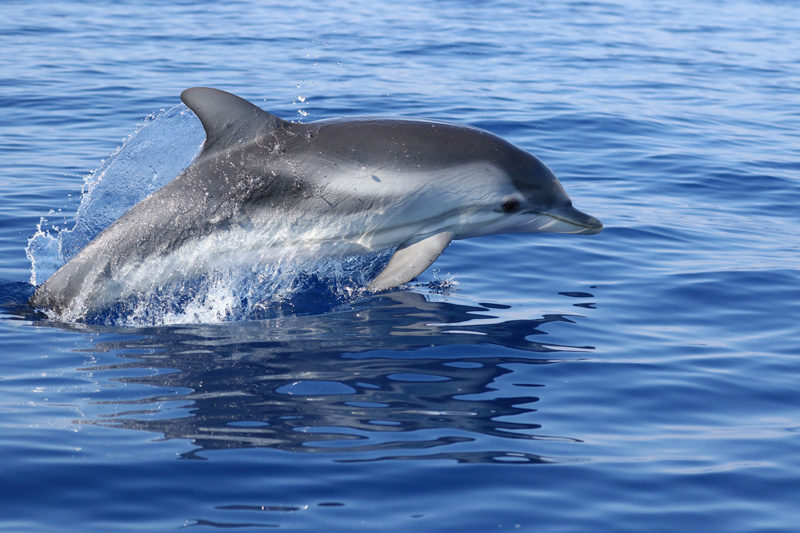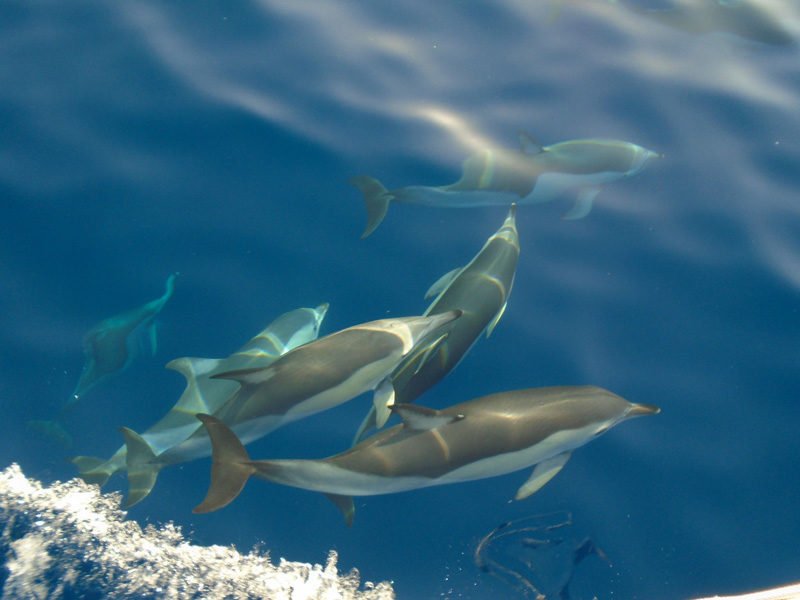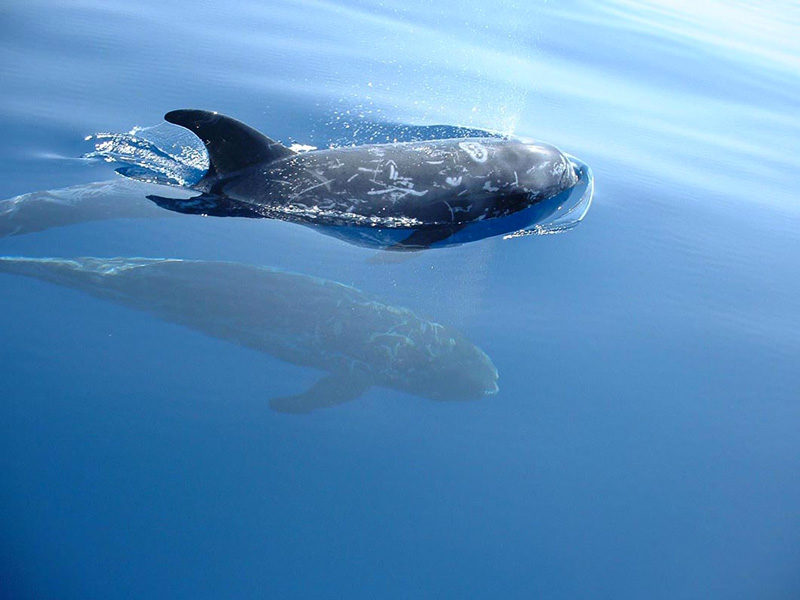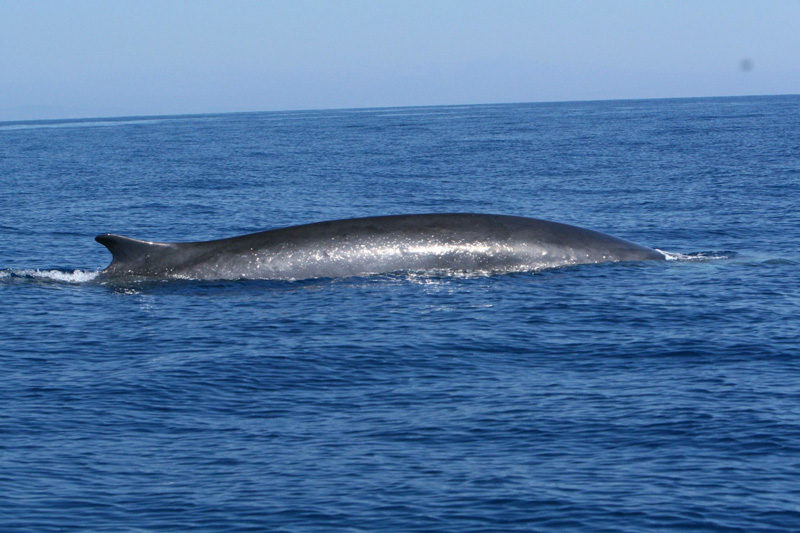3.4. Cetacean species in the Mediterranean Sea
Eight cetacean species are regularly present in the Mediterranean Sea. These include the common bottlenose dolphin (Tursiops truncatus), the short-beaked common dolphin (Delphinus delphis), the striped dolphin (Stenella coeruleoalba), the fin whale (Balaenoptera physalus), the sperm whale (Physeter macrocephalus), the long-finned pilot whale (Globicephala melas), the Risso’s dolphin (Grampus griseus) and the Cuvier’s beaked whale (Ziphius cavirostris). Additionally, two more species (considered visitors to the Mediterranean Sea), the false killer whale (Pseudorca crassidens) and the humpback whale (Megaptera novaeangliae), have been recorded.
The common bottlenose dolphin (Tursiops truncatus) is the best known and most widely distributed of all Delphinidae species. It has a fusiform body shape (streamlined); body colour varies from dark grey on the dorsal cape to pale grey on the side and white on the underside, which may have a pinkish glow when the summer water temperature is high. The bottlenose dolphin measures between 1.9 m to 4 m when adult and weighs between 100 kg and 500 kg. Bottlenose dolphins feed mostly on benthic fish and small squids, and therefore are often in direct competition with fishermen. They are famous for their curiosity and this makes them prone to entanglement, particularly in gillnets, which in turn is a major form of premature death for the species. Pollution, overfishing and habitat destruction reduces the numbers of these dolphins and confines them to limited habitats.
The striped dolphin (Stenella coeruleoalba) is a small, globally distributed, pelagic dolphin found in warm temperate and tropical waters. It is the most abundant dolphin species in the Mediterranean Sea. Striped dolphins congregate in dense pods. The size of pods can vary from 10-30 to several hundreds of individuals, and their composition is flexible. The species maximum life span has been estimated as approximately 58 years. Being an oceanic dolphin, striped dolphins mainly feed on small shoaling fish and pelagic squids, with an obvious preference for the latter in the Mediterranean. In order to reach their prey, they may dive some 700 meters. These dolphins are very fast swimmers and, in the Mediterranean, are estimated to travel at an average of 15 km per hour. They are extremely active animals that often jump several meters high and display various other acrobatics above surface. They do not have many natural predators in the Mediterranean. However, humans are the greatest threat to their populations.

The short-beaked common dolphin (Delphinus delphis) is abundant throughout the continental shelf and pelagic waters of tropical and warm temperate regions in the Atlantic and Pacific Oceans. Until the early 1970’s this species was one of the most abundant Mediterranean species, but has since experienced a major decline leading to total disappearance from large parts of the previous range. Organised culling campaigns in many Mediterranean countries were the factor leading to their disappearance. The dolphins were perceived as competitors for fish and were considered “pests”. Depending on their habitat, common dolphins can feed on a great variety of prey. Their diet includes small schooling fish such as herring, anchovies, sardines and also cephalopods. Common dolphins can be found in schools of up to several thousand animals in the oceans. However, these large schools are composed of smaller family subunits of about 20-30 probably closely related individuals. These individuals usually hunt in smaller groups, splitting away from the large school for foraging but returning for travelling and socializing. In general, they are extremely active, fast moving and engage in spectacular aerial behaviours. Their average life span is estimated to be over 30 years. Habitat degradation from human activities, incidental catch and overfishing is likely to be one of the reasons of common dolphin disappearance in the Mediterranean and Black Seas.

Risso’s dolphins (Grampus griseus) are relatively large dolphins measuring up to 4m in length. Most distinctive is the blunt head without beak and dark coloration dominated by whitish scars which they accumulate throughout life, making older animals appear almost white. Risso’s dolphins are distributed worldwide in tropical and temperate seas with preference for deep offshore waters and coastal areas with narrow continental shelves. The Risso’s dolphin is present in the entire Mediterranean Sea and is considered a regular inhabitant, although its abundance throughout the basin is unknown. Within the Mediterranean Sea, the Risso’s dolphin is mostly encountered in deep pelagic waters, in particular over steep shelf slopes and submarine canyons.

The Cuvier’s beaked whale (Ziphius cavirostris) is a large-sized odontocete with adults reaching between 5.5 and 7m in length. Adult bodies are generally covered with scratches, probably due to interactions during the mating season. Of all the beaked whales the Cuvier’s beaked whale has the widest distribution range: global, only absent in polar waters. Information on their sighting and stranding distribution reflects the Cuvier’s beaked whale preference for deep waters (usually deeper than 1.000 m), slope and canyons where it can find its favorite prey: squid. This species is very vulnerable to the underwater noise produced by the military and seismic exploratory sonar, which influences the communication between the individuals and their orientation.
The fin whale (Balaenoptera physalus) is a widely-distributed species found throughout the major oceans, particularly in cool temperate and polar latitudes. They also inhabit the Mediterranean Sea and research shows that these animals form a genetically distinct population. Fin whales are generally found alone or in small groups, with occasional congregations of up to 100 animals in feeding areas. They mainly feed on krill (small copepods), and small fish, particularly mackerel, herring and capelin. The body is hydro-dynamically shaped with pleated throat grooves which can be expanded when feeding. They feed by lunging through the water open mouthed and filtering the engulfed water using baleen. Like other Balaenopteridae, fin whales feed in the summer, ingesting up to one tonne of prey per day, and fast in the winter. They are the second largest mammal on earth, exceeded in size only by the blue whale. The body is dark grey above and white or cream coloured on the underside. Females may grow up to 27 m long, weighing nearly 100 tonnes. They may live longer than 80 years. In Mediterranean they are listed as Vulnerable (VU).


